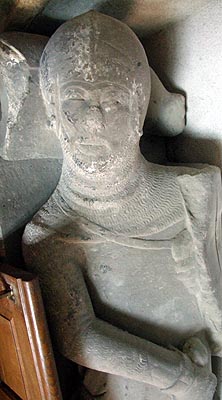
RBH Home
Maps & Travels
Articles
Legends
Towns & Villages
Castles & Houses
Churches
Biographies
Gentry
Family History
Odds & Ends
Mail David
 Sir Nicholas Carew
Sir Nicholas Carew(d. 1311)
Born: circa 1255
'Baron Carew of Moulsford'
Died: 1311 at Carew Castle, Pembrokeshire
Nicholas was the son of Nicholas Carew Senior and his wife, Avice Tuitt. His father was an important marcher lord living at Carew Castle in Pembrokeshire from which the family took its name. They were descended from Walter FitzOther, the Constable of Windsor Castle in Berkshire, and their main residence in England was Moulsford Manor in the same county, where they lived when attending the Royal Court in Oxford or Woodstock, or even London.
Sir Nicholas became a high ranking officer and distinguished soldier under King Edward I. His early career is obscure, but, in 1278, he received Royal letters of protection upon travelling to Ireland for two years on the King's service. In 1299, he gave letters of attorney, as he was again going abroad with Aymer de Valence, the Earl of Pembroke. By the following year, he was serving in the King's army in Scotland where he was present at the Siege of Caerlaverock Castle in the July. One can imagine that he fought bravely in many of King Edward's Scottish, Welsh and French campaigns. His reputation was such that he attended the Parliament called at Lincoln, in January 1301, to consider the letter from Pope Boniface VIII claiming his position as feudal overlord of Scotland. He signed the barons reply as 'Lord of Moulsford', but because he had not actually received a writ of summons, his position as Lord Carew is not generally accepted. Later, in June that same year, he was summoned, as from Devon, to perform military service in person against the Scots and to attend the muster at Berwick. In August 1305, he was appointed Constable of Bothwell Castle.
At home, 'Lord' Carew was
responsible for much of the medieval construction of Carew Castle between
1280 and 1310. He died in 1311 and was buried the parish church of Carew
Cheriton, where an effigy of a knight, believed to be his, remains to this
day. He had married twice, firstly to Amicia Peverel by whom he had four
sons, and secondly to Avice Martin by whom he had a further four son and a
single daughter. He was succeeded in his estates by his eldest surviving
son, John.
